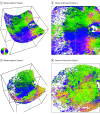Polarization-Sensitive OCT Imaging of Scleral Abnormalities in Eyes With High Myopia and Dome-Shaped Macula
- PMID: 38451488
- PMCID: PMC10921350
- DOI: 10.1001/jamaophthalmol.2024.0002
Polarization-Sensitive OCT Imaging of Scleral Abnormalities in Eyes With High Myopia and Dome-Shaped Macula
Abstract
Importance: The relevance of visualizing scleral fiber orientation may offer insights into the pathogenesis of pathologic myopia, including dome-shaped maculopathy (DSM).
Objective: To investigate the orientation and density of scleral collagen fibers in highly myopic eyes with and without DSM by polarization-sensitive optical coherence tomography (PS-OCT).
Design, setting, and participants: This case series included patients with highly myopic eyes (defined as a refractive error ≥6 diopters or an axial length ≥26.5 mm) with and without a DSM examined at a single site in May and June 2019. Analysis was performed from September 2019 to October 2023.
Exposures: The PS-OCT was used to study the birefringence and optic axis of the scleral collagen fibers.
Main outcomes and measures: The orientation and optic axis of scleral fibers in inner and outer layers of highly myopic eyes were assessed, and the results were compared between eyes with and without a DSM.
Results: A total of 72 patients (51 [70.8%] female; mean [SD] age, 61.5 [12.8] years) were included, and 89 highly myopic eyes were examined (mean [SD] axial length, 30.4 [1.7] mm); 52 (58.4%) did not have a DSM and 37 (41.6%) had a DSM (10 bidirectional [27.0%] and 27 horizontal [73.0%]). Among the 52 eyes without DSM, the 13 eyes with simple high myopia had primarily inner sclera visible, displaying radially oriented fibers in optic axis images. In contrast, the entire thickness of the sclera was visible in 39 eyes with pathologic myopia. In these eyes, the optic axis images showed vertically oriented fibers within the outer sclera. Eyes presenting with both horizontal and bidirectional DSMs had clusters of fibers with low birefringence at the site of the DSM. In the optic axis images, horizontally or obliquely oriented scleral fibers were aggregated in the inner layer at the DSM. The vertical fibers located posterior to the inner fiber aggregation were not thickened and appeared thin compared with the surrounding areas.
Conclusions and relevance: This study using PS-OCT revealed inner scleral fiber aggregation without outer scleral thickening at the site of the DSM in highly myopic eyes. Given the common occurrence of scleral pathologies, such as DSM, and staphylomas in eyes with pathologic myopia, recognizing these fiber patterns could be important. These insights may be relevant to developing targeted therapies to address scleral abnormalities early and, thus, mitigate potential damage to the overlying neural tissue.
Conflict of interest statement
Figures





Comment on
-
Decoding Scleral Structures With Polarized Light.JAMA Ophthalmol. 2024 Apr 1;142(4):319-320. doi: 10.1001/jamaophthalmol.2024.0199. JAMA Ophthalmol. 2024. PMID: 38451495 No abstract available.
References
-
- Hogan MJ, ed. The sclera. In: Histology of the Human Eye. WB Saunders; 1971.
-
- de la Maza MS, Tauber J, Foster CS. Structural considerations of the sclera. In: de la Maza MS, Tauber J, Foster CS, eds. The Sclera. Springer; 2012:1-27.
Publication types
MeSH terms
Substances
LinkOut - more resources
Full Text Sources
Medical

